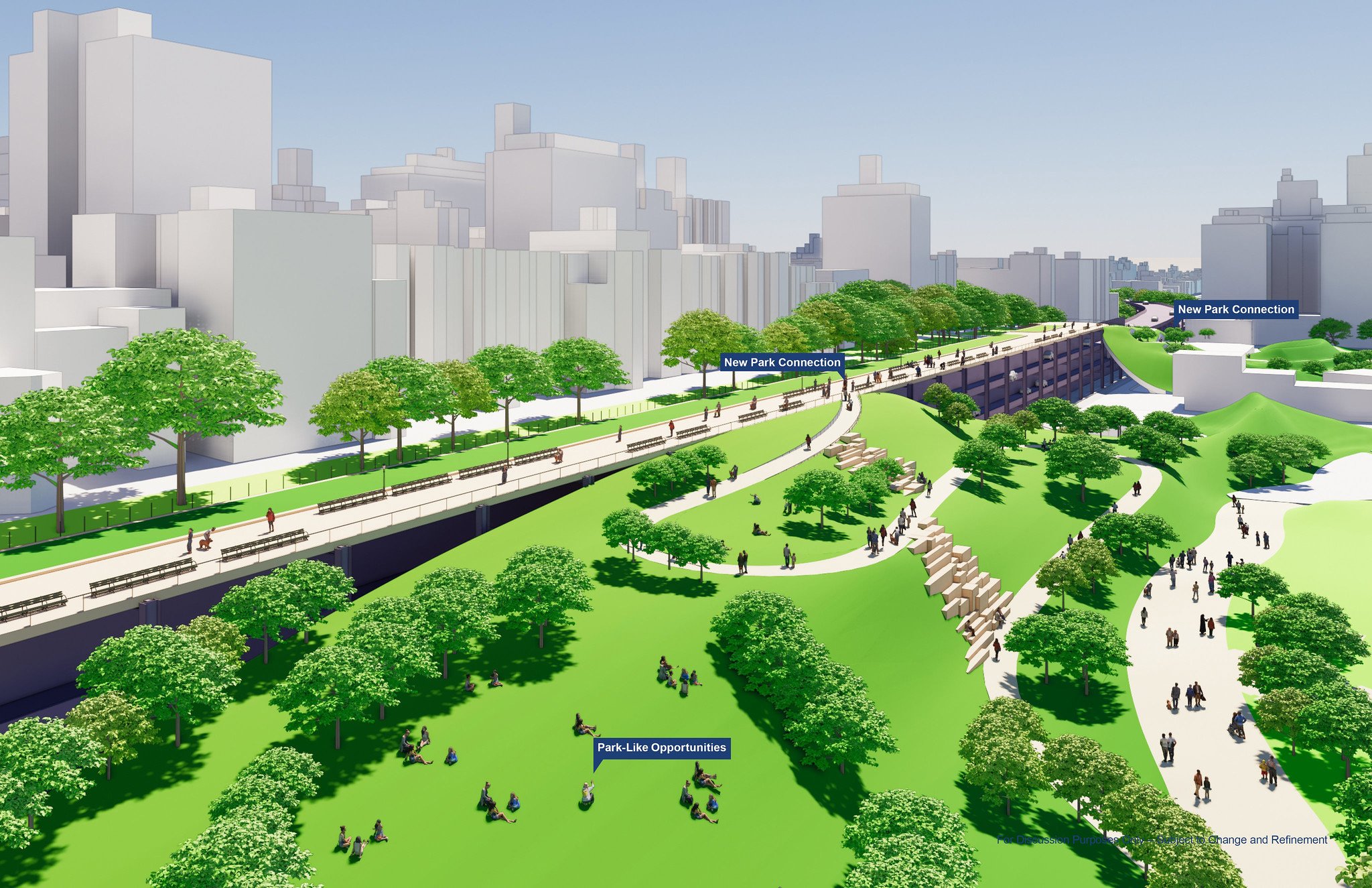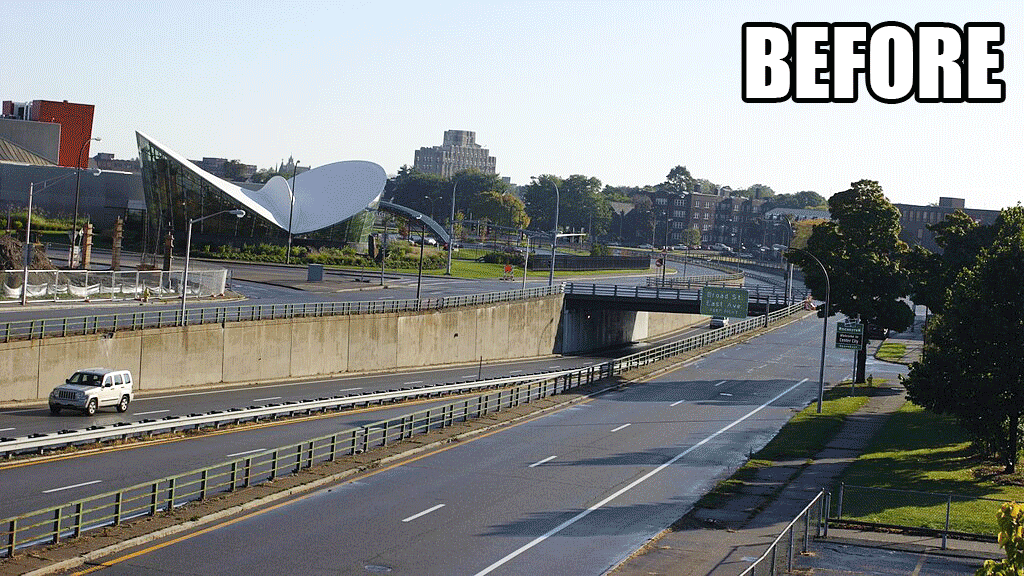The Brooklyn-Queens Expressway Isn’t a Park Project, It’s a Highway Expansion
The expiration date for the Brooklyn-Queens Expressway (BQE) is fast approaching and New Yorkers are eager to know its fate. For years, residents and city officials have been divided over whether to rehabilitate the often traffic-choked expressway or dismember it entirely, but everyone could agree that addressing the crumbling conduit's fate is urgent. In March 2023, it appeared the city and state finally landed on a plan. To the surprise of many Brooklynites, that plan involves expanding the BQE.
The city hinted at plans for the BQE back in December 2022, when three renderings—The Stoop, The Terrace, and The Lookout—were released. The renderings focused on the 1.5-mile section known as BQE Central, which suspends traffic using a triple-cantilever design. BQE Central has been so belabored by the weight of trucks it wasn’t designed to carry that multiple lanes have been closed off for years to ensure it doesn’t collapse. Locals were as concerned about its stability as they were hopeful that the long-term closures could give way to a Brooklyn without the BQE of the past: a six-lane behemoth that rattled adjacent brownstones.
However, critics immediately pointed to how deceptively the renderings packaged an unwanted return to what once was a “park project,” even referring to the concepts as archetypal greenwashing. “I think given their focus on rebuilding a six-lane behemoth, they did a lovely job of presenting it with lots of green magic marker, and I think they’re creative people given the wrong premise,” remarked Brooklyn Heights Association board member and resident, Cindy McLaughlin, after the release of the three renderings.
The newest concepts have been met with equal consternation: “The [DOT] meeting on the BQE has a lot of focus on beautification and very little on pollution, congestion, or safety. Greenwashing ‘shoulders’ as transit lanes for bus lines that don’t exist. It’s lipstick on a pig,” William Meehan tweeted. Hayden Clarkin, a vocal transit activist, also chimed in: “Expanding the highway and partially covering it with a park doubles down on our past mistakes. Who would want to enjoy a park that's level with a double-decker freeway?”
And just to clarify, please stop referring to the expansion of highway on/off ramps by public housing as a "park project." This literally couldn't be further from the truth. pic.twitter.com/0kpPyeitg7
— Hayden Clarkin (@the_transit_guy) March 3, 2023
Added irony for Brooklynites is that the plans paraded by the New York City Department of Transportation (NYCDOT) and the Mayor’s Office threaten the integrity of some of Brooklyn’s existing and most celebrated parks. The Brooklyn Heights Promenade was subject to obstruction and partial demolition in a 2019 proposal, which was met with fierce local pushback. That proposal involved constructing a temporary highway to accommodate freight, truck, and other vehicular traffic during the BQE’s reconstruction. While the exact route floated by NYCDOT then is unlikely to materialize now, thanks to opposition, Streetsblog reported that implementing a temporary highway is still on the table.
Another park under threat is Brooklyn Bridge Park, one of the most expensive park projects in the country. “Making it three [wider] lanes in each direction means a tougher problem to solve and probably intrusion into Brooklyn Bridge Park,” former NYC Traffic Commissioner Sam Schwartz observed on WNYC’s Brian Lehrer Show. In a piece for Streetsblog, Hank Gutman, likewise a former transportation commissioner who oversaw the park’s construction and currently sits on its board, agreed with Schwartz. “Sam is absolutely right that expanding the footprint of the highway would seriously damage Brooklyn Bridge Park. So would a temporary highway and many of the other things that the DOT is apparently considering,” he told Streetsblog.
In its presentations, NYCDOT has attributed rebuilding and expanding the expressway to three lanes in part to modern federal standards. Those standards mandate a second shoulder, which could mean a two-lane roadway would be up to 44 feet wide, compared with the current cantilever’s 34 foot width. A three-lane highway could be as large as 56 feet, nearly twice the width of the current BQE Central. While NYCDOT entertained adapting the federally mandated shoulder or potential third lane to serve as a “HOV or high-capacity transit lane at peak hours,” these uses are not promised and at this time, not part of official concepts.
For Winnie Hu, a transportation reporter for the New York Times, the decision to rebuild and expand the BQE is also a way to tap into federal money, which “won’t be available forever.” For the many New Yorkers that Hu interviewed, utilizing the unprecedented funding streams opened up by the $1.2 trillion infrastructure law toward “restoring the six-lane behemoth” is “a step backwards.” Part of that law is the $1 billion Reconnecting Communities Pilot Program, championed by Transportation Secretary Pete Buttigieg, which aims to redress historic harms caused by past infrastructure projects.
In fact, dozens of city, state, and federal officials cosigned a letter addressed to Buttigieg expressing concern regarding the BQE’s imminent expansion. The letter urges the U.S. Department of Transportation to “support maintaining the highway at two lanes of car and truck traffic in each direction,” asserting that expanding the roadway will induce congestion and worsen air quality along the commercial and residential corridors it bisects. The claims are widely supported by decades of evidence affirming induced demand, as well as the research conducted by the 17-member BQE Expert Panel convened in 2021 to study potential futures for the deteriorating expressway. The expert panel’s findings argued two lanes each way were possible and preferable to an expansion.
These findings stand in stark contrast to NYCDOT’s hypothesis across its presentations: Retaining the BQE at two lanes of traffic has been actively worsening air quality for residents in its periphery. For many Brooklynites intimately familiar with the realities of living near the expressway, the DOT’s claims are “ridiculous.”
“Expanding the BQE would be a multi-billion-dollar project that would only bring more pollution, noise, traffic, and cars and trucks parking in neighborhoods,” Kathy Park Price of Transportation Alternatives told Strong Towns. For Price, combating noise and air pollution doesn’t come with “propping up an outdated highway,” rather, it involves concerted efforts to reduce car dependency.
With the timeline for the BQE’s reconstruction stretching well beyond a decade, the promised “park-like opportunities” at the expense of existing greenspaces are not an appealing trade-off to many New Yorkers. Its condition needs to be addressed urgently and while federal dollars offer expediency, for advocates like Price, “the worst case scenario would be an expanded BQE.”






Detroit’s local leaders have long favored eliminating I-375, a sunken highway separating the eastern parts of the city from downtown…but MDOT’s plan to convert it into a six-lane road is not the future they envisioned.